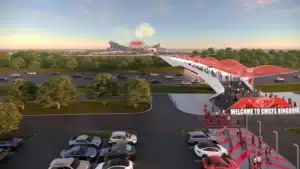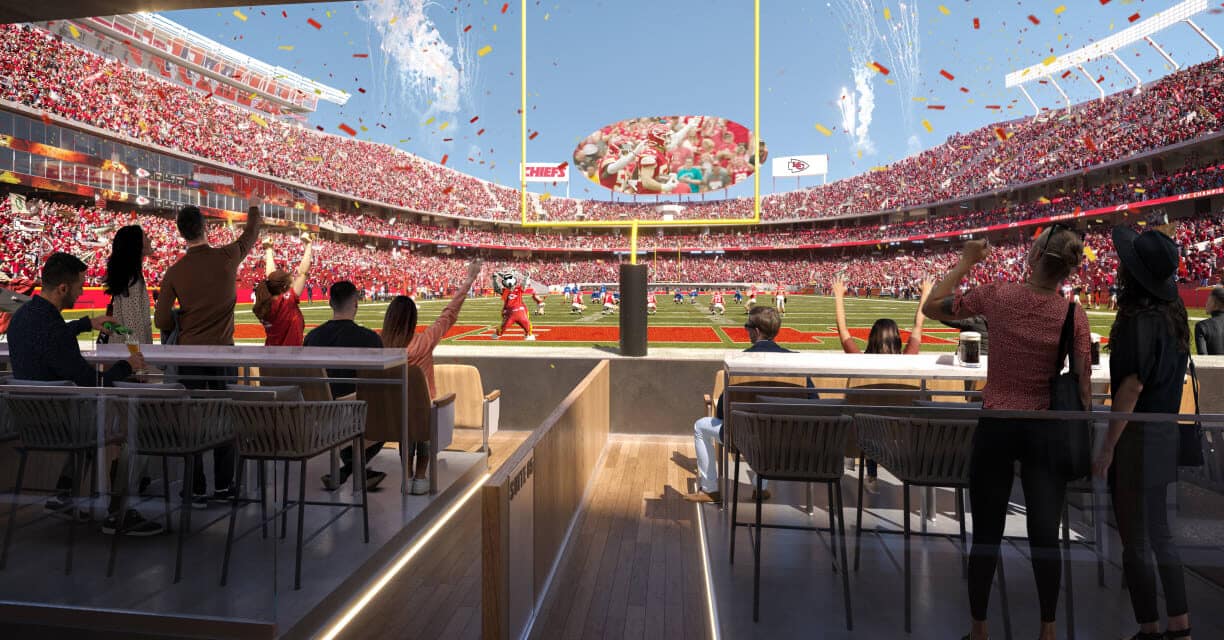BUNKER DOWN: The construction of new field-level suites in the end zones are part of the proposed renovations to Arrowhead Stadium, a 52-year-old building. (Courtesy team)
Sports construction expert provides context
The Kansas City Chiefs yesterday unveiled renderings of an overhaul of Arrowhead Stadium tied to a cost estimate of $800 million, not too far off from what it would cost to build a new venue.
The project hinges on a public vote on April 3 by Jackson County residents to repeal an existing 3/8 cent sales tax set to end in 2031 and replace it with a new sales tax at the same rate that would extend it for another 40 years.
Sports designer Populous, the Chiefs’ consultant, produced multiple renderings, which include new sideline clubs, bunker suites in the end zones, a new concourse connection bridge to create a 360-degree wraparound for fans in the upper deck, a canopy to protect those upper deck patrons, and new covered tailgate spaces built over the current site of Kauffman Stadium for game day and offseason activities.
The tailgate zone would be contingent on the Kansas City Royals building a new $1 billion-plus downtown ballpark tied to the same sales tax mechanism.
Populous deferred to the Chiefs for comment. As of press time, Mark Donovan was not available to speak about the project.
Chiefs owner Clark Hunt told local media the team would provide $300 million in private funding for the project.
The price tag of $800 million is a big number for a renovation, considering it’s about half the cost to build a new NFL facility. The Tennessee Titans, for example, came up with similar numbers to renovate 25-year-old Nissan Stadium, before deciding to scrap those plans in favor of constructing a new building next door to the current venue, which is targeted to open in 2026.
Conversely, the Jacksonville Jaguars have committed to transforming Everbank Stadium into an enclosed facility at a cost of $1 billion, pending approval of public money to help pay for the reconstruction.
As a general rule, sports architects say once you reach a point where the cost to renovate climbs to half the cost of a new building, it makes greater sense to proceed with new construction over upgrading the existing structure.
Big picture, it all depends on which factors are driving the team’s strategy for upgrading their facility in general, according to Dale Koger, vice president and general manager of PCL Construction, a builder of sports venues.
Koger knows Arrowhead well. Fourteen years ago, he was with Turner Construction, the general contractor for the the last round of stadium renovations in Kansas City. (Turner is also the contractor for modifying field dimensions for 2026 World Cup matches at Arrowhead).
Years ago, Koger said, many stadium renovations were tied to increasing seating capacity, a trend that has reversed itself in recent years, to the point that most team owners would prefer to reduce the number of seats and increase ticket prices for the existing inventory to generate more revenue. Modifying the bowl to develop a greater number of premium seat options, which the Chiefs have proposed, is part of that equation, he said.
In Kansas City, Arrowhead Stadium is beloved among its fans, which is part of what’s driving the revitalization of a building that opened in 1972. Arrowhead has always been a great venue to watch a game with a tight seating bowl conducive to producing a loud and intimidating atmosphere for opponents. It’s assumed that a big chunk of the $800 million would go to updating and fortifying the aging infrastructure.

TAILGATE CITY: A rendering shows an expanded tailgate zone on the site of where Kauffman Stadium now sits, next to Arrowhead Stadium. (Courtesy team)
The new renovations plan would build on the $375 million in Arrowhead improvements completed in 2010 and designed by Populous. The 450,000 square foot expansion created new sideline clubs and a group suite in the upper deck, plus a hall of fame, a sports lab for student education and a redeveloped plaza with statues of legendary Chiefs players and Lamar Hunt, the team’s founder.
“If the framework is pretty much intact, why spend $200 million to $400 million more, when you could modify what you already have,” Koger said. “It’s not a one size fits all. But if you’re going to spend $800 million on an NFL stadium, you’re getting pretty darn close to being able to build new on a different site for not much more money.”
The Chiefs’ strong tailgating reputation in the parking lots surrounding Arrowhead and Kauffman also comes into play. The NFL team already has that space and expanding the tailgate zone to the ballpark site is a a big advantage compared with trying to build a new stadium downtown on a tight site without the acres of land to provide for a key piece of the fan experience in Kansas City, Koger said.
“That would seem to validate trying to do something where Arrowhead is today,” he said. “If the Royals are leaving, you’ve got even more space for parking and tailgating. That seems to make sense.”
All things being equal, the Chiefs’ tremendous success of late, winning three of the past five Super Bowls, is another factor in their favor for their vision of a modernized Arrowhead.
“Clark Hunt is a great owner, and now would seem to be a good time to raise some cash to upgrade, because they’ve certainly been on a roll on the field,” Koger said.







